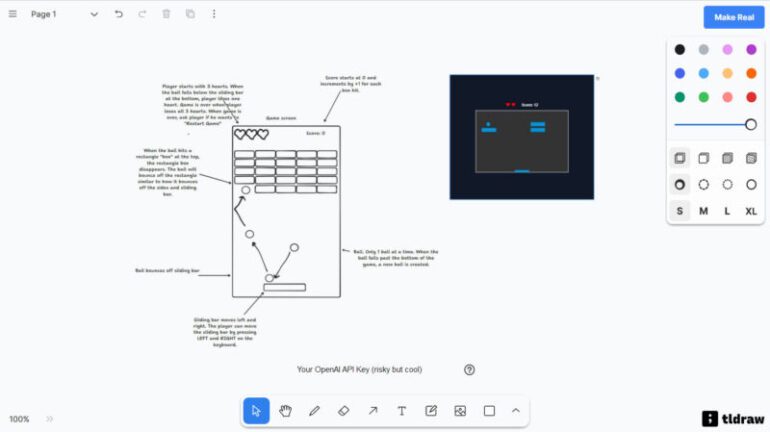TL;DR:
- tldraw unveils “Make it Real” prototype, utilizing OpenAI’s GPT-4V API.
- Users can draw software images, and AI converts them into functional Tailwind CSS and JavaScript web code.
- Remarkable demonstrations include interactive games and complex interfaces.
- Accessing the feature requires an OpenAI API key, with potential security implications.
- tldraw, an open-source collaborative whiteboard tool, secures $2.7 million in funding.
- GPT-4V’s ability to interpret visual prompts powers “Make it Real.”
- A glimpse into a future where AI simplifies software development and interface design.
Main AI News:
In a stunning revelation that has sent shockwaves through the developer community, the collaborative whiteboard app maker, “tldraw,” has unveiled its groundbreaking prototype known as “Make it Real.” This revolutionary feature harnesses the power of artificial intelligence, specifically OpenAI’s GPT-4V API, to transform hand-drawn images of software into functional reality. The implications of this innovation are nothing short of astounding.
Designer Kevin Cannon, in a viral X thread, expressed his astonishment at the capabilities of “Make it Real.” The feature enables users to create functioning sliders, object rotation mechanisms, color-changing interfaces, and even interactive games like tic-tac-toe with a mere stroke of the digital pen. The possibilities seem endless as others have demonstrated their creations, ranging from clones of classic games like Breakout and Pong to intricate visual state charts.
To experience the magic of “Make It Real,” users can access a live demo online. However, a word of caution: utilizing this feature necessitates the use of an OpenAI API key, which comes with potential security risks. Unauthorized access to your API key could lead to substantial financial liabilities, given that OpenAI charges based on data usage. Alternatively, for those technically inclined, running the code locally is an option, though it still requires OpenAI API access.
Tldraw, conceived by Steve Ruiz in London, is an open-source collaborative whiteboard tool that offers an expansive canvas for drawing, text, and media without the need for a login. Since its launch in 2021, the project has garnered $2.7 million in seed funding and enjoys the support of GitHub sponsors. The recent integration of the GPT-4V API, alongside the “draw-a-ui” design prototype by Sawyer Hood, has propelled tldraw into a realm of AI-powered creativity that was previously unimaginable.
GPT-4V, a remarkable iteration of OpenAI’s large language model, possesses the unique ability to interpret visual images and employ them as prompts. As elucidated by AI expert Simon Willison on X, “Make it Real” operates by generating a base64 encoded PNG of the drawn components, which is then submitted to GPT-4 Vision with a system prompt and instructions to transmute the image into functional Tailwind CSS and JavaScript code.
In essence, “Make it Real” offers a tantalizing glimpse into a potential future of software development and interface design. It envisions a world where crafting a functional prototype is as effortless as sketching a visual concept and letting an AI model bring it to life. Developer Michael Dubakov aptly captured the sentiment, remarking, “OK, @tldraw is officially insane. It is really interesting where we end up in 5 years… I can’t keep up with the innovation pace anymore.” The future indeed holds boundless possibilities in the realm of AI-powered creativity.
Conclusion:
tldraw’s “Make it Real” prototype represents a significant leap in software development, offering a glimpse into a future where AI-driven creativity transforms the industry. Its potential to streamline the creation of functional prototypes has the potential to disrupt the market, making software development more accessible and efficient for developers and designers alike. This innovation could pave the way for new possibilities and opportunities within the tech sector, redefining the standards of interface design and development.

